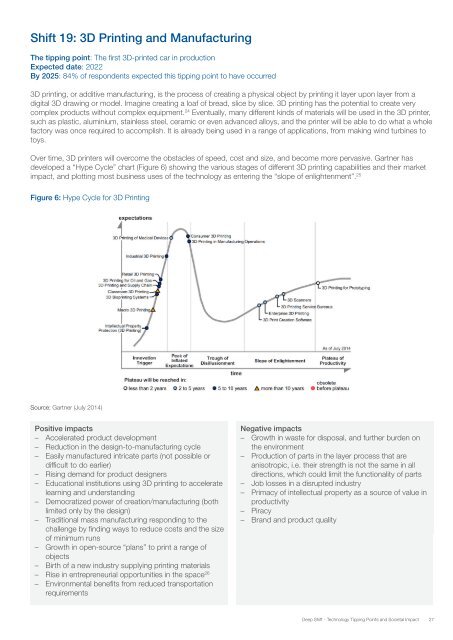Deep Shift Technology Tipping Points and Societal Impact
WEF_GAC15_Technological_Tipping_Points_report_2015
WEF_GAC15_Technological_Tipping_Points_report_2015
- No tags were found...
You also want an ePaper? Increase the reach of your titles
YUMPU automatically turns print PDFs into web optimized ePapers that Google loves.
<strong>Shift</strong> 19: 3D Printing <strong>and</strong> Manufacturing<br />
The tipping point: The first 3D-printed car in production<br />
Expected date: 2022<br />
By 2025: 84% of respondents expected this tipping point to have occurred<br />
3D printing, or additive manufacturing, is the process of creating a physical object by printing it layer upon layer from a<br />
digital 3D drawing or model. Imagine creating a loaf of bread, slice by slice. 3D printing has the potential to create very<br />
complex products without complex equipment. 24 Eventually, many different kinds of materials will be used in the 3D printer,<br />
such as plastic, aluminium, stainless steel, ceramic or even advanced alloys, <strong>and</strong> the printer will be able to do what a whole<br />
factory was once required to accomplish. It is already being used in a range of applications, from making wind turbines to<br />
toys.<br />
Over time, 3D printers will overcome the obstacles of speed, cost <strong>and</strong> size, <strong>and</strong> become more pervasive. Gartner has<br />
developed a “Hype Cycle” chart (Figure 6) showing the various stages of different 3D printing capabilities <strong>and</strong> their market<br />
impact, <strong>and</strong> plotting most business uses of the technology as entering the “slope of enlightenment”. 25<br />
Figure 6: Hype Cycle for 3D Printing<br />
Source: Gartner (July 2014)<br />
Positive impacts<br />
––<br />
Accelerated product development<br />
––<br />
Reduction in the design-to-manufacturing cycle<br />
––<br />
Easily manufactured intricate parts (not possible or<br />
difficult to do earlier)<br />
––<br />
Rising dem<strong>and</strong> for product designers<br />
––<br />
Educational institutions using 3D printing to accelerate<br />
learning <strong>and</strong> underst<strong>and</strong>ing<br />
––<br />
Democratized power of creation/manufacturing (both<br />
limited only by the design)<br />
––<br />
Traditional mass manufacturing responding to the<br />
challenge by finding ways to reduce costs <strong>and</strong> the size<br />
of minimum runs<br />
––<br />
Growth in open-source “plans” to print a range of<br />
objects<br />
––<br />
Birth of a new industry supplying printing materials<br />
––<br />
Rise in entrepreneurial opportunities in the space 26<br />
––<br />
Environmental benefits from reduced transportation<br />
requirements<br />
Negative impacts<br />
––<br />
Growth in waste for disposal, <strong>and</strong> further burden on<br />
the environment<br />
––<br />
Production of parts in the layer process that are<br />
anisotropic, i.e. their strength is not the same in all<br />
directions, which could limit the functionality of parts<br />
––<br />
Job losses in a disrupted industry<br />
––<br />
Primacy of intellectual property as a source of value in<br />
productivity<br />
––<br />
Piracy<br />
––<br />
Br<strong>and</strong> <strong>and</strong> product quality<br />
<strong>Deep</strong> <strong>Shift</strong> - <strong>Technology</strong> <strong>Tipping</strong> <strong>Points</strong> <strong>and</strong> <strong>Societal</strong> <strong>Impact</strong><br />
27











